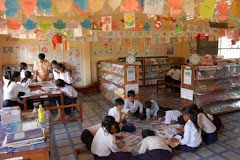
I arrived on this earth after Martin Luther King was shot, after most “flower children” stopped protesting Vietnam, quite a few years after the Holocaust, and many, many, MANY years after the American Revolutionary War. The same can be said for many of you.
And yet we know about those people and events listed above. How? We learned about many of them from reading “historical fiction” books like
Johnny Tremain, Number the Stars,
For Freedom,
The Lion, the Witch and the Wardrobe (Ok, so it's a fantasy, but the first few chaps are about WWII :)),
Sweet Clara and the Freedom Quilt,
Al Capone Does my Shirts, Healing Water,
Samarai Shortstop,
The Brooklyn Nine,
The Scarlet Letter, and
One Million Men and Me.
So today let’s talk about historical fiction: books set in the past, with characters from the past, that resonate with kids and teens today.
At the SCBWI Carolinas Annual Fall Conference not long ago, our own NC Historical Fiction guru
Joyce Moyer Hostetter, (author of “Blue,” and other great books of historical fiction books for teens,) shared the following tips for “Writing Historical Fiction for Young People.”
She said:
In writing historical fiction, the author should:
1.) “Find the story” --- It might be a historic event, person, or theme in your own back yard, neighborhood, or your own family’s history.
2.) “Tell the time” --- Along with your plot, include in your story things that give the reader a sense of the era the story happens in. This can be done by including dates, having your characters speak in phrases and words common at that time, and grounding your story among political events and the cultural backdrop of the era.
3.) “Ask the Experts” --- People love to be interviewed about their own life experiences. “You validate their story by (incorporating their knowledge of the time and their experiences into your story and) telling it well.” Joyce says “People want to share with you. So be really brave about calling total strangers.”
4.) “SHOW the place” --- Include in your story local landmarks, vivid nouns and adjectives detailing the food, plants, and local features of your setting. “Readers love to read about places in their own home town, and speech patterns they recognize.”
5.) “Cite your sources” -- Editors want to publish your book with confidence, knowing that those little tidbits of place, time, dialogue, and event are historically accurate. So cite all those sources you used!
But where does a person come up with a story for historical fiction? And how do we find out more about those historical facts, events, and people that we‘re thinking of writing about?
Joyce suggested some great resources:
Ÿ Historical photos of people and buildings
Ÿ Old newspapers
Ÿ Old letters and diaries
Ÿ Memoir’s related to your topic
Ÿ Museums
Ÿ Songs/Music from the time you are researching
Ÿ Dictionaries
Ÿ History books
Ÿ “Writer’s digest books on historic time periods”
Ÿ And websites like
http://www.si.edu/ (The Smithsonian Institute,) and
http://www.loc.gov/loc/infopub/ (The Library of Congress).

So, if you feel like you’re ready for a new writing project perhaps you should flip through your great aunt’s old photo albums, reminisce through your old high school year books, or start wandering around the old buildings in your city or state. You never know what you might find… and the story that comes out of it could be brilliant!
















